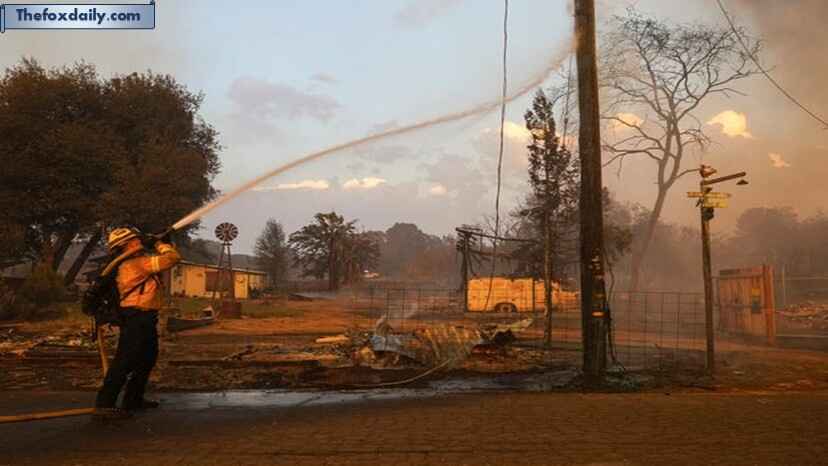
After dozens of lightning strikes were reported in the area, causing evacuations and burning structures in a historic Gold Rush town, firefighters are fighting a string of wildfires that broke out in north-central California.
As of September 3, the California Department of Forestry and Fire Protection (Cal Fire) reports that the TCU September Lightning Complex has burnt more than 20 square miles in Calaveras, Tuolumne, and Stanislaus counties. At least 22 “distinct fires” make up the complex, which started on September 2 when dry thunderstorms rolled into California.
The complex, which was still burning in the foothills of the Sierra Nevada, has more than 630 firefighters assigned to it, according to Cal Fire. The agency said fire crews were challenged by weather conditions as gusty winds lingered in the region from nearby thunderstorm cells.
“The fire has exhibited active runs in critically dry tall grass, brush, and timber fuels,” Cal Fire said in a statement. “The terrain is challenging to access, requiring fire crews to hike in by foot to many remote locations.”
The 6-5 Fire was the biggest fire in the complex, having burned almost 10 square miles in Tuolumne County and endangering the few surviving buildings in Chinese Camp, a historic site and small village about 40 miles from Yosemite National Park. The entire town and its environs had to be evacuated due to the rapidly spreading fire.
The complex has destroyed and damaged a “number of structures,” according to Cal Fire, and a damage inspection team is being sent out. Numerous evacuation notices were still in effect, and the government issued a warning that several towns in the area, including ancient tribal sites, were under danger.
The fires follow approximately 4,800 lightning strikes between midnight and 5:30 a.m. local time on September 2, which were mostly located between the Central Valley and the inland East Bay, according to the National Weather Service. The area was more vulnerable to flames as a result of dry vegetation and dry lightning.

September Lightning Complex at TCU
According to Cal Fire, the 6-5, 2-2, 2-8, 6-2, and 2-7 fires are the biggest ones at the TCU September Lightning Complex. According to the government, there was no containment of the flames as of September 3.
Due to the fires’ “dangerous rate of spread” and threat to several structures, Cal Fire issued mandatory evacuation orders along with extensive warnings that went farther. Parts of neighboring routes were also closed as a result of the fires.
The office of California Governor Gavin Newsom declared on September 2 that the state has received a grant from the Federal Emergency Management Agency for fire management assistance to aid with firefighting.
“The TCU September Lightning Complex fires ignited the morning of Tuesday, September 2, 2025 as part of a statewide storm that saw more than 9,000 lightning strikes,” Newsom’s office stated in a news statement. “The 2-7 fire is actively burning in Calaveras and Tuolumne counties with several communities threatened in Calaveras County.”
According to Newsom’s administration, more than 300 local people were already under evacuation orders, while another 1,400 were under evacuation alerts.
Chinese Camp: What is it?
The Cal Fire Tuolumne-Calaveras Unit reported on September 3 that firefighters were concentrating on constructing containment lines and fortifying existing lines as the 6-5 Fire persisted in posing a threat to Chinese Camp.
According to local news station KCRA and NBC News, the fire at Chinese Camp damaged or destroyed a number of homes. The Cal Fire Tuolumne-Calaveras Unit reported that the Chinese Camp School was unaffected by the fire.
The town’s historic post office building was destroyed by the fire, according to KCRA. According to California State Parks, the 1854-built stone and brick post office remained in use until it was destroyed by fire.
Driven out of a nearby settlement, Chinese miners established in the California Gold Rush village of Chinese settlement circa 1850, according to Visit Tuolumne County. Approximately “5,000 Chinese miners in addition to as many Americans and Europeans” used to reside in the rural village, according to the county’s tourism website.
California State Parks states that “Chinese Camp was headquarters for stagelines in early 1850s and for several California Chinese mining companies.” “Much surface gold was found on hills and flats.”
The TCU September Lightning Complex is burning across multiple fires and impacting communities in Calaveras and Tuolumne counties.
Cal OES is coordinating with local, state, and federal partners to support firefighting efforts and community needs.
Visit https://t.co/xUxzIcH5jL… pic.twitter.com/0F2cHOtquY
— California Governor’s Office of Emergency Services (@Cal_OES) September 3, 2025
What is dry lightning?
“Dry thunderstorms,” which produce little to no rainfall, are when dry lightning happens. On Sept. 2, across California, the rain evaporated in dry air before reaching the ground, according to the weather service, adding: “Most areas saw less than 0.10 inches of rain & there were a few fire starts.”
With dry lightning, there is a serious risk of wildfires. The weather service states that lightning strikes are more likely to start wildfires in drier storms and drier vegetation. This is because, in the absence of rain to assist hydrate it, cloud-to-ground lightning can readily ignite dry fuel.
More than 530 wildfires were started by more than 110,000 lightning strikes in August, according to a study released by Cal Fire on September 3. According to the organization, those fires ignited by lightning scorched 45 square miles in all.
“We are currently seeing increased fire activity due to the lightning activity seen over the last few days, and conditions remain critical,” Cal Fire stated in a statement. “Please stay prepared, stay aware, and have a plan in case a wildfire threatens your community.”
For breaking news and live news updates, like us on Facebook or follow us on Twitter and Instagram. Read more on Latest World on thefoxdaily.com.

COMMENTS 0